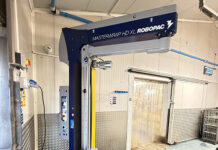The checkweigher’s function as the ‘policeman’ of the packing line is evolving to one where it can make a significant contribution to overall efficiency and profitability, says Philip Grove of Ishida Europe
THE checkweigher is usually viewed as a necessity to ensure packs meet the correct average or minimum weight requirements.
Given the accuracy of today’s multihead weighers, it could be argued that the checkweigher has almost become superfluous. However, although a multihead weigher can consistently deliver the correct target weight, it cannot guarantee that the weighed product subsequently reaches the final pack intact. Problems with the distribution or filling system, or a tear in a pack that leads to product falling out, will not be picked up; and on automated lines, there may not be the personnel available to spot such mishaps immediately. To avoid these situations turning into problems, the checkweigher is invaluable.
The need to maximise efficiencies at every stage of production and packing also remains critical. At the same time, the growth in own-label products has led to a significant increase, leading to shorter production runs and many more changeovers.
Factories are therefore becoming increasingly automated, as companies seek to adopt the principles of Industry 4.0 and lean manufacturing.
Nevertheless, however well-designed and integrated a line may be, the fact that it is made up of different pieces of equipment means it is unlikely to operate consistently at its peak rate.
As a result, the ability to spot unplanned downtime and react to them as quickly as possible becomes the critical factor in delivering the highest level of efficiencies. This is where the checkweigher is able to take on an increasingly important role.
Many of today’s models have the software capability to deliver a huge amount of valuable information that enables companies to take instant action to improve the performance or efficiency of their lines, so much so that payback on this investment can be extremely fast.
Significantly, this data is instantly available and accessible – it does not require the information to be downloaded and then manually assessed in order for a report to be compiled; and remote access means information can quickly be compiled and compared between different lines, even at different locations.
In this way, the software plays a valuable role in assessing a line’s Overall Equipment Effectiveness (OEE) by constantly monitoring it in terms of availability, performance and quality.
The combination of these three elements provides an OEE percentage that uniquely identifies how efficient a production line is running, and can show this value for a factory, a production line, or a particular product at any time frame, in order to identify potential areas of improvement.
This ability to analyse the data in order to suggest improvements is a significant benefit. In one of our recent installations, a pet food manufacturer packing around 700 cans of product every minute on an eight hour shift saw a payback on the investment of just a few months through the ability to better control the amount of raw ingredients that went into each can.
While these excessive weights might be the result of a fault in another piece of equipment, they could uncover the fact that the line is running at too high a speed for it to deliver maximum efficiencies. The fastest speeds do not always equate to the highest efficiencies; giveaway is amplified by the amount of product going through the line. If by lowering the overall speed, the amount of giveaway is significantly reduced, this will ultimately deliver a much better overall efficiency rate.
This is particularly important in light of the current trend to reduce the weight of products; the lower the target weight, the greater the potential for giveaway unless this is carefully monitored and appropriate action taken.
In essence, the data that can be derived from a checkweigher provides a constant and real time health check on all areas of the line. And it enables accurate comparisons to be carried out between different lines. This can be valuable where the lines are in different locations; using the checkweighers to supply and interpret the data means everyone is working to the same standards.
The checkweigher will always be required for its ‘policeman’ role that ensures businesses are compliant with all relevant weights and measures requirements. However, with companies seeking added-value from their products and services, the modern checkweighers’ ability to deliver high levels of relevant and pertinent data provides the detailed knowledge that will enable businesses to improve their OEE.
In this way they can compete effectively and maximise their profitability even in the face of intense competition.















